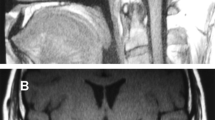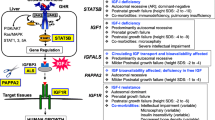Abstract
Mutational analysis of the growth hormone 1 (GH1) gene and its promoter in a patient with GH neurosecretory dysfunction (GHND) revealed a heterozygous new deletion of one base 7-bp downstream from the 3′-splice site of exon 4 (IVS4’del+7) of the GH1 gene and two new heterozygous mutations at sites −135 and −138 of the GH1 promoter. In addition, two polymorphisms at sites −301 and −308 of the GH1 promoter were observed. All other family members had either the −301/−308 polymorphisms or the IVS4’del+7 mutation, but none had both. The IVS4’del+7 mutation located close to the splice donor site possibly interferes with the success of the splicing process, or the mutant transcripts are highly unstable because of nonsense-mediated mRNA decay. The −135/−138 mutations, albeit in close proximity to a putative Pit-1 recognition site, do not seem to affect binding of this transcription factor. The combination of the two polymorphisms, −301/−308, results in significantly reduced DNA-binding activity as monitored by electrophoretic mobility-shift assay. Transcription factor recognition site analysis of the GH1 promoter (MatInspector) revealed that HES1, one of the effectors of the Notch signalling system, is the only transcription factor whose binding is expected to be disrupted by each haplotype or by their combination. We provide evidence that the combination of −301/−308 polymorphisms with the IVS4’del+7 mutation in a GHND patient probably accounts for the reduced amount of growth hormone spontaneously secreted from his pituitary gland and for the severe growth delay.





Similar content being viewed by others
References
Tannenbaum GS (1993) Genesis of episodic growth hormone secretion. J Pediatr Endocrinol 6(3–4):273–282
Isaksson O (2004) GH, IGF-I, and growth. J Pediatr Endocrinol Metab 17:1321–1326
Carter-Su C, Schwartz J, Smit LS (1996) Molecular mechanism of growth hormone action. Annu Rev Physiol 58:187–207
Chen EY, Liao YC, Smith DH, Barrera-Saldana HA, Gelinas RE, Seeburg PH (1989) The human growth hormone locus: nucleotide sequence, biology, and evolution. Genomics 4:479–497
Frohman LA, Jansson JO (1986) Growth hormone releasing hormone. Endocr Rev 7:223–253
Melmed A (1987) Pituitary growth factors. In: Muller EE, Macleod RM (eds) Neuroendocrine perspectives. Springer, Berlin Heidelberg New York, pp 27–24
Castrillo JL, Bodner M, Karin M (1989) Purification of growth hormone specific transcription factor GHF-1 containing homeobox. Science 243:814–817
McCormic A, Brady H, Theil LE, Karin M (1990) Regulation of the pituitary-specific homeobox gene GHF1 by cell-autonomous and environmental cues. Nature 345:829–832
Chen RP, Ingraham HA, Treacy MN, Albert VR, Wilson I, Rosenfeld MG (1990) Autoregulation of pit-1 gene expression mediated by two cis-active promoter elements. Nature 346:583–586
Giordano M, Marchetti C, Chiorboli E, Bona G, Richiardi PM (1997) Evidence for gene conversion in the generation of extensive polymorphism in the promoter of the growth hormone gene. Hum Genet 100:249–255
Horan M, Millar D, Hedderich J, Lewis G, Newsway V, Neil M, Fryklund L, Procter A, Krawczak M, Cooper D (2003) Human growth hormone 1 (GH1) gene expression: complex haplotyde-dependent influence of polymorphic variation in the proximal promoter and locus control region. Human Mutat 2:408–423
Dennison EM, Syddall HE, Rodriguez S, Voropanov A, Day INM, Cooper C (2004) Polymorphism in the growth hormone gene, weight in /infancy, and adult bone mass. J Clin Endocrinol Metab 89:4898–4903
Wells J (1996) Binding in the growth hormone receptor complex. Proc Natl Acad Sci USA 1:1–6
Argetsinger LS, Campbell GS, Yang X, Witthuhn BA, Silvennoinen O, Ihle JN, Carter-Su C (1993) Identification of JAK2 as a growth hormone receptor-associated tyrosine kinase. Cell 74:237–244
Herrington J, Smith LS, Schwartz J, Carter-Su C (2000) The role of STAT proteins in growth hormone signalling. Oncogene 19:2585–2597
Spiliotis BE, August GP, Hung W, Sonis W, Mendelson W, Bercu BB (1984) Growth hormone neurosecretory dysfunction. A treatable cause of short stature. JAMA 4 251:2223–2230
Bercu BB, Schulman D, Root AW, Spiliotis BE (1986) Growth hormone (GH) provocative testing frequently does not reflect endogenous GH secretion. J Clin Endocrin Metab 63:709–716
Zadik Z, Zung A, Sarel R, Cooper M (1997) Evolving growth hormone deficiency in children with subnormal secretion of growth hormone. J Pediatr 130:481–484
Takahashi Y, Shirono H, Arisaka O, Takahashi K, Yagi T, Koga J, Kaji H, Okimura Y, Abe H, Tanaka T, Chihara K (1997) Biologically inactive growth hormone caused by an amino acid substitution. J Clin Invest 100:1159–1165
Moseley CT, Mullis PE, Prince MA, Phillips JA III (2002) An exon splice enhancer mutation causes autosomal dominant GH deficiency. J Clin Endocrin Metab 87:847–852
Ziros PG, Rojas Gil AP, Georgakopoulos T, Habeos I, Kletsas D, Basdra EK, Papavassiliou AG (2002) The bone-specific transcriptional regulator Cbfa1 is a target of mechanical signals in osteoblastic cells. J Biol Chem 277:23934–23941
Ziros PG, Georgakopoulos T, Habeos I, Basdra EK, Papavassiliou AG (2004) Growth hormone attenuates the transcriptional activity of Runx2 by facilitating its physical association with Stat3beta. J Bone Miner Res 19:1892–1904
Lou H, Gagel RF (2001) Alternative ribonucleic acid processing in endocrine systems. Endocr Rev 22:205–225
Abdul-Latif H, Leiberman E, Brown MR, Carmi R, Parks JS (2000) Growth hormone deficiency type IB caused by cryptic splicing of the GH-1 gene. J Pediatr Endocrinol Metab 13:21–28
He K, Wang X, Jiang J, Guan R, Bernstein KE, Sayeski PP, Frank SJ (2003) Janus kinase 2 determinants for growth hormone receptor association, surface assembly, and signalling. Mol Endocrinol 17:2211–2227
Fasshauer M, Klein J, Kralisch S, Klier M, Lössner U, Blüher M, Paschke R (2004) Growth hormone is a positive regulator of adiponectin receptor 2 in 3T3-L1 adipocytes. FEBS Lett 558:27–32
Salemi S, Yousefi S, Lochmatter D, Eble A, Deladoey J, Robinson IC, Simon HU, Mullis PE (2007) Isolated autosomal dominant growth hormone deficiency: stimulating mutant GH-1 gene expression drives GH-1 splice-site selection, cell proliferation, and apoptosis. Endocrinology 148:45–53
Cogan JD, Ramel B, Lehto MJ, Phillips JA 3rd, Prince M, Blizzard RM, de Ravel TJ, Brammert M, Groop L (1995) A recurring dominant negative mutation causes autosomal dominant growth hormone deficiency a clinical research center study. J Clin Endocrinol Metab 12:3591–3595
Binder G, Ranke MB (1995) Screening for growth hormone (GH) gene splice-site mutations in sporadic cases with severe isolated GH deficiency using ectopic transcript analysis. J Clin Endocrinol Metab 80:1247–1252
Missarelli C, Herrera L, Mericq V, Carvallo P (1997) Two different 5′ splice site mutations in the growth hormone gene causing autosomal dominant growth hormone deficiency. Hum Genet 101:113–117
Hayashi Y, Kamijo T, Yamamoto M, Ohmori S, Phillips JA 3rd, Ogawa M, Igarashi Y, Seo H (1999) A novel mutation at the donor splice site of intron 3 of the GH-I gene in a patient with isolated growth hormone deficiency. Growth Horm IGF Res 9:434–437
Vivenza D, Guazzarotti L, Godi M, Frasca D, di Natale B, Momigliano-Richiardi P, Bona G, Giordano M (2006) A novel deletion in the GH1 gene including the IVS3 branch site responsible for autosomal dominant isolated growth hormone deficiency. J Clin Endocrinol Metab 91:980–986
Procter AM, Phillips JA 3rd, Cooper DN (1998) The molecular genetics of growth hormone deficiency. Hum Genet 103:255–272
Conti E, Izaurralde E (2005) Nonsense-mediated mRNA decay: molecular insights and mechanistic variations across species. Curr Opin Cell Biol 17:316–325
Alonso CR (2005) Nonsense-mediated RNA decay: a molecular system micromanaging individual gene activities and suppressing genomic noise. Bioessays 27:463–466
Jarriault S, Brou C, Logeat F, Schroeter EH, Kopan R, Israel A (1995) Signalling downstream of activated mammalian Notch. Nature 377:355–358
Chen J, Crabbe A, Van Duppen V, Vankelecom H (2006) The notch signaling system is present in the postnatal pituitary: marked expression and regulatory activity in the newly discovered side population. Mol Endocrinol 20:3293–3307
Raetzman LT, Ross SA, Cook S, Dunwoodie SL, Camper SA, Thomas PQ (2004) Developmental regulation of Notch signaling genes in the embryonic pituitary: Prop1 deficiency affects Notch2 expression. Dev Biol 265:329–340
Ward RD, Raetzman LT, Suh H, Stone BM, Nasonkin IO, Camper SA (2005) Role of PROP1 in pituitary gland growth. Mol Endocrinol 19:698–710
Acknowledgment
We thank the European Social Fund (ESF), the Operational Program for Educational and Vocational Training II (EPEAEK II), and particularly the Program “Pythagoras II” for funding the present work.
Author information
Authors and Affiliations
Corresponding authors
Additional information
Andrea Paola Rojas-Gil and Panos G. Ziros contributed equally to this work.
Rights and permissions
About this article
Cite this article
Rojas-Gil, A.P., Ziros, P.G., Kanetsis, E. et al. Combined effect of mutations of the GH1 gene and its proximal promoter region in a child with growth hormone neurosecretory dysfunction (GHND). J Mol Med 85, 1005–1013 (2007). https://doi.org/10.1007/s00109-007-0200-7
Received:
Revised:
Accepted:
Published:
Issue Date:
DOI: https://doi.org/10.1007/s00109-007-0200-7




